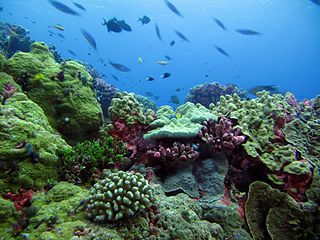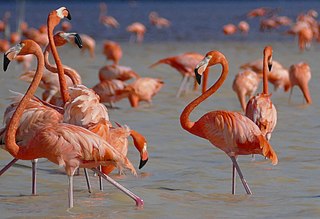This is an index of conservation topics. It is an alphabetical index of articles relating to conservation biology and conservation of the natural environment.

The Ramsar Convention on Wetlands of International Importance Especially as Waterfowl Habitat is an international treaty for the conservation and sustainable use of Ramsar sites (wetlands). It is also known as the Convention on Wetlands. It is named after the city of Ramsar in Iran, where the convention was signed in 1971.

A transboundary protected area (TBPA) is an ecological protected area that spans boundaries of more than one country or sub-national entity. Such areas are also known as transfrontier conservation areas (TFCAs) or peace parks.

The W National Park or W Regional Park is a major national park in West Africa around a meander in the Niger River shaped like the letter W. The park includes areas of the three countries Niger, Benin and Burkina Faso, and is governed by the three governments. Until 2008, the implementation of a regional management was supported by the EU-funded project ECOPAS. The three national parks operate under the name W Transborder Park. The section of W National Park lying in Benin, measuring over 8,000 km2 (3,100 sq mi), came under the full management of African Parks in June 2020. In Benin, W National Park is contiguous with Pendjari National Park which is also under the management of African Parks.

An Important Bird and Biodiversity Area (IBA) is an area identified using an internationally agreed set of criteria as being globally important for the conservation of bird populations.

The wildlife of Niger is composed of its flora and fauna. The protected areas in the country total about 8.5 million hectares, which is 6.6 percent of the land area of the country, a figure which is expected to eventually reach the 11‑percent target fixed by the IUCN with the addition of more areas under the reserve category. Conservation of wildlife is ensured by laws and regulations enacted by the government of Niger, which has enforced a permanent ban on hunting so that animals such as lions, hippos and giraffes are safe in the wild.

Protected areas of Poland include the following categories, as defined by the Act on Protection of Nature of 16 April 2004, by the Polish Parliament:

The Aïr and Ténéré National Nature Reserve is a national nature reserve in Niger. It includes several overlapping reserve designations, and is designated a UNESCO World Heritage Site. It covers both the eastern half of the Aïr Mountains and the western sections of the Ténéré desert.
The Dosso Partial Faunal Reserve is a nature reserve in the southwest Dosso Region of Niger. It is a Partial Faunal Reserve IUCN type IV, established 1 January 1962. The reserve covers 3,065 square kilometres in the mouth of Dallol Bosso valley, a seasonal wash and ancient riverbed running from the Azawagh region, near where it reaches the Niger River valley. It is situated near the W du Niger National Park.

The Termit Massif Total Reserve is a nature reserve in the southeast of Niger which was established in January 1962. In March 2012, a national nature and cultural reserve was established covering an area of 100,000 square kilometres (39,000 sq mi), including the entire area of the Termit Massif and Tin Toumma desert, making it the largest single protected area in Africa. The area provides habitat for many critically endangered species. Prominent among them is the addax antelope, which is categorized under the IUCN Red List as one of the rarest and most endangered species in the world; about 300 of them are reported in the reserve. A conservation effort has been launched by the Government of Niger in collaboration with many international conservation agencies. The reserve has also been declared an UNESCO World Heritage Site for the biodiversity value of the Termit Massif and surrounding Sahara Desert and for the cultural value of its archaeological sites.

The Tamou Total Reserve is a nature reserve in the southwest of Niger. It is a Total Faunal Reserve IUCN type IV, covering some 75,600 hectares within the Tillaberi Region. The reserve abuts W du Niger, and is primarily dedicated to the protection of African Elephant populations which migrate through the region.
The Tadrès Total Reserve (T'adéras/Tadress) is a nature reserve in the central north of Niger, southwest the city of Agadez. It is a Total Faunal Reserve IUCN type IV, covering some 788,928 hectares within the Agadez Region. The reserve follows the northeast - southwest flow of the Tadrès valley, a Kori or seasonal wash and ancient river bed south of the Aïr Mountains. It was originally dedicated to the protection of Oryx populations which have largely disappeared from the region. In the 1940s, the valley was an important migration route for the animals from the Tenere desert to the Adar in the south of the country. It remains a transhumance route for domesticated cattle and camels, as well as wild Dorcas and Ménas Gazelles
The Gadabedji Total Reserve is a nature reserve in the central region of Niger. It is a Total Faunal Reserve IUCN type IV, covering some 76,000 hectares within the northern tip of the Maradi Region, just north of the town of Dakoro, and south of the border with the Agadez Region. The reserve is also recognized biosphere reserve by the Unesco since 2017.

The Aïr and Ténéré Addax Sanctuary is a nature reserve in the north center of the nation of Niger. The reserve forms part of the larger Aïr and Ténéré National Nature Reserve, which is a UNESCO World Heritage Site. The Aïr and Ténéré National Nature Reserve covers 77,360 square kilometres (29,870 sq mi), of which 12,800 square kilometres (4,900 sq mi) form the Aïr and Ténéré Addax Sanctuary.

The Termit Massif is a mountainous region in south-eastern Niger. Just to the south of the dunes of Ténéré desert and the Erg of Bilma, the northern areas of the Termit, called the Gossololom, consist of black volcanic peaks rising from the surrounding seas of sand. The southern Termit is a roughly east–west ridge of heavily eroded black sandstone. Its foothills to the southwest are the Koutous hills.

The World Database on Protected Areas (WDPA) is the largest assembly of data on the world's terrestrial and marine protected areas, containing more than 260,000 protected areas as of August 2020, with records covering 245 countries and territories throughout the world. The WDPA is a joint venture between the United Nations Environment Programme World Conservation Monitoring Centre and the International Union for Conservation of Nature World Commission on Protected Areas.

Despite being a relatively small country, Albania is exceedingly rich in biodiversity. Its ecosystems and habitats support over 5,550 species of vascular and non-vascular plants and more than 15,600 species of coniferous and non-coniferous evergreens, most of which are threatened at global and European levels. The country has made recent efforts to expand its network of protected areas which now include: 11 national parks, 1 marine park, 718 nature monuments, 23 managed nature reserves, 11 protected landscapes, 4 World Heritage Sites, 4 Ramsar sites and other protected areas of various categories, that when combined, account for 21.36% of the territory. Furthermore, a biosphere reserve, 45 important plant areas and 16 important bird areas are found in the country.

Ría Celestun Biosphere Reserve is a biosphere reserve in Mexico. It is located on the northwestern Yucatán Peninsula in the states of Yucatán and Campeche. The reserve is home to extensive mangrove wetlands, and rich in birds and other wildlife.

Protected areas of Kiribati include marine protected areas managed by the Environment and Conservation Division, of the Kiribati Ministry of Environment, Lands and Agricultural Development. Kiribati, in partnership with the New England Aquarium and Conservation International (CI), manages the Phoenix Islands Protected Area (PIPA), which is a World Heritage Site that was established in 2006, and is the second largest of the world's marine protected areas. The U.S. administered Pacific Remote Islands Marine National Monument is currently the world's largest designated marine protected area (MPA), and is to the north and north-east of the PIPA.















